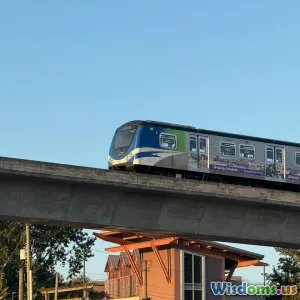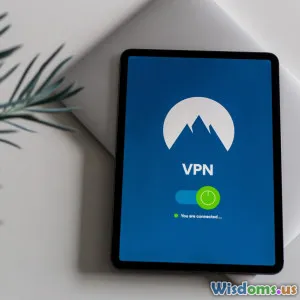
Comparing OSPF and BGP Which Routing Protocol Wins
23 min read Explore OSPF vs BGP routing protocols, their differences, use cases, and performance factors for network professionals. (0 Reviews)
Comparing OSPF and BGP: Which Routing Protocol Wins?
In the ever-evolving landscape of computer networks, the choice of a routing protocol can make or break a network’s scalability, stability, and efficiency. Two of the most prominent protocols—OSPF (Open Shortest Path First) and BGP (Border Gateway Protocol)—are often pitted against each other. Each has its champions, each is a workhorse in substantial digital infrastructures, but when it comes to the critical question of which one you should trust for your network—who comes out ahead?
Let’s navigate through the technical nuances, best-use cases, strengths, and trade-offs of OSPF and BGP, to aid you in making the most informed decision for your networking needs.
Decoding OSPF: The Inner Workings

OSPF, or Open Shortest Path First, is an interior gateway protocol (IGP) designed for use within a single autonomous system, such as a large organization's internal network. As a link-state protocol, OSPF builds a complete map of network topology through periodic sharing of link-state advertisements (LSAs) between routers.
Key Characteristics:
- Link-state Routing: Unlike distance-vector protocols (like RIP), OSPF knows the exact topology of the whole network, thanks to regular updates.
- Fast Convergence: When network topology changes (such as a link failure), OSPF quickly recalculates the best paths, often within seconds.
- Hierarchical Design: OSPF introduces the concept of areas to scale for large networks, minimizing the volume of routing information passed and reducing processing load.
Real-world Example: A global retail enterprise uses OSPF to connect its hundreds of branches distributed countrywide. Each branch is grouped into different OSPF areas, managed centrally by IT. When a new store is added, it’s assigned to the proper area, and OSPF seamlessly integrates its routing information, ensuring minimal downtime and rapid recognition network-wide.
Useful OSPF Features:
- Cost-based Routing: Routing decisions are made based on interface cost—a configurable value reflecting network link bandwidth.
- Authentication: OSPF supports authentication, making it challenging for unauthorized devices to participate in routing.
- Equal-Cost Multi-Path (ECMP): Facilitates better bandwidth utilization by supporting load balancing over multiple equal-cost routes.
Exploring BGP: The Internet’s Backbone

BGP is widely known as the routing protocol that runs the internet. Formally, it is an exterior gateway protocol (EGP), and it connects autonomous systems (AS), not just individual routers within a single organization but potentially across continents and disparate administrative domains.
Core Features:
- Path-vector Protocol: BGP exchanges entire path information (AS-PATH), which uniquely determines the route a packet will take through many networks.
- Scalability: BGP is designed to handle the vast size of the internet, capable of efficiently processing hundreds of thousands of route entries.
- Policy-based Routing: BGP allows granular control over routing decisions using attributes like AS-PATH, LOCAL_PREF, and more.
Industry Insight: Internet service providers (ISPs) rely on BGP to route traffic globally. For example, when you access a website hosted thousands of miles away, BGP has likely determined not just the route, but also the tolerance for certain types of traffic, detour preferences, and peering agreements along the way.
Notable Advantages:
- Robust Traffic Control: BGP enables network admins to prioritize certain routes based on business agreements, cost, or performance.
- Security Measures: While BGP is famously targeted in certain hijacking incidents, protocols like BGPsec and RPKI are being implemented at scale to increase security.
- Multiprotocol Extensions: MP-BGP extends BGP’s capabilities to carry routing information for multiple protocols like IPv6 and MPLS VPNs.
OSPF vs BGP: The Fundamental Differences

To pit OSPF against BGP fairly, it’s essential to recognize that they are tuned to different operating environments and solve distinct routing problems.
| Characteristic | OSPF | BGP |
|---|---|---|
| Type | Interior Gateway Protocol (IGP) | Exterior Gateway Protocol (EGP) |
| Routing Algorithm | Link State (Dijkstra’s Algorithm) | Path Vector |
| Update Scope | Within Autonomous System | Between Autonomous Systems |
| Convergence Speed | Fast | Slower (but more predictable) |
| Scalability | Medium–High (with areas) | Very High (internet-scale) |
| Route Control | Limited (cost-based only) | Highly Granular (policy-based) |
| Typical Use Cases | Enterprise, Data Center LAN Routing | ISP, Enterprise Border Routing |
Example Scenario:
- A multinational company may use OSPF internally to quickly adapt to changes in its site-to-site WAN topology, while BGP orchestrates connections to external partners, cloud services, and redundant ISPs across geopolitical boundaries.
Analogous View:
- Think of OSPF as the highly efficient subway system within a major city—optimized for local traffic, rapid rerouting, and reliable coverage.
- BGP, on the other hand, is the network of intercontinental flights connecting nations—concerned with large-scale, optimized, and policy-driven routing that transcends individual city subways.
When to Choose OSPF: Use Cases and Limitations

If your challenge is ensuring fast, reliable routing among numerous internal routers—think corporate office networks, data centers, or campus-style infrastructures—OSPF often shines brightest.
Best-fit Scenarios for OSPF
- Well-organized Internal Networks: OSPF shines in environments divided into subnets or regions, where area-based hierarchy keeps the routing table sizes manageable and boosts performance.
- Rapid Failover Needs: Data centers or critical business networks benefit from OSPF’s fast convergence during outages or configuration changes. A failed redundant link is quickly swapped for the best alternative with minimal packet loss.
- Security-conscious Environments: Built-in authentication, plus restricted protocol communication within the organization, lowers the exposure surface for malicious actors.
- Consistent Hardware/Software Environments: OSPF thrives when all routers and devices support modern link-state mechanics and rapid LSA propagation.
Recognized Limits
- Less Granular Route Manipulation: OSPF’s cost metric is fixed per link, making it less effective when complex routing policies or dynamic preference adjustment is needed.
- Inter-AS Inflexibility: OSPF is not suitable for networks that must exchange routes with separate autonomous systems (e.g., multi-provider scenarios).
Tip: Use OSPF where a layered, secure, and highly adaptive approach to routing is required, particularly if the network is growing moderately but not at an internet scale.
Where BGP Wins: Border and Beyond

BGP dominates wherever networks interconnect on a grand scale—at the edges of organizations, between ISPs, or whenever complex routing control and business logic are key.
BGP's Core Strengths
- Interconnecting Autonomous Systems: BGP was built to route traffic between organizations, often those with their own distinct internal policies and agendas.
- Policy-driven Routing: Administrators can define which paths to prefer, deny, or alter—using attributes such as AS-PATH, COMMUNITY, and LOCAL_PREF—giving unparalleled flexibility.
- Support for Multiple Connection Types: Whether you’re managing dual-homed sites, load balancing across multiple connections, or designing highly available WAN links, BGP is your toolkit of choice.
- Scalability With Control: BGP handles route tables containing over a million prefixes (as seen in 2024’s global BGP table), easily dwarfing anything a typical IGP can manage.
Real-world Approach: Major cloud service providers, such as AWS or Google Cloud, rely on BGP peering with customer networks to direct billions of requests per hour, applying sophisticated routing policies that account for cost, latency, redundancy, and regulatory requirements.
Potential Challenges
- Not Optimized for Internal Dynamics: BGP’s slower convergence tolerates the sort of instability common between autonomous systems, but can be less suitable for restless internal environments where blips and outages need split-second correction.
- Higher Complexity: Mastery of BGP policies, route filtering, and attribute manipulation is essential. Misconfiguring BGP can result in global outages or high-profile route leaks, as evidenced by well-publicized incidents involving misrouted YouTube traffic in 2008 or the large-scale outages of 2021.
Tip: Employ BGP whenever your organization spans multiple ISPs, has complex traffic engineering needs, or must share/control routes with external neighbors.
Security Considerations: Safeguarding Your Routes

IPv4 and IPv6 networks are under constant threat from route hijacking, spoofing, and accidental misconfigurations. Both OSPF and BGP have been strengthened over the years, but their security models differ in philosophy and approach.
OSPF’s Security Posture
- Built-in Authentication: OSPF supports type 1 (plain text) and type 2 (cryptographic) authentication out of the box. By ensuring only trusted routers can participate, OSPF stops many accidental and some deliberate attacks at the door.
- Local Scope: Because OSPF typically operates only within a single organization, its risk exposure is naturally lower.
BGP’s Global Stakes
- Global Trust Model: Since BGP governs routes across organizational borders, it faces a broader risk spectrum. Malicious or misconfigured BGP updates can potentially misroute internet traffic worldwide.
- Modern Defenses: Efforts like RPKI (Resource Public Key Infrastructure) and BGPsec have become vital. RPKI enables cryptographic validation of route advertisements, while BGPsec secures AS-path propagation.
- Examples in Recent Memory: In 2024, a series of BGP route leaks demonstrated that organizations poorly managing filtering policies can inadvertently create black holes or intercept foreign network traffic, often making headlines. Operators must implement robust route filtering, max-prefix controls, and advanced monitoring.
Actionable Advice:
- For OSPF: Always configure cryptographic authentication and isolate OSPF domains using area design.
- For BGP: Deploy RPKI, strong inbound/outbound filtering, and frequent audits of routing policy changes.
Performance and Convergence: Speed vs. Stability

The pace and predictability with which a routing protocol adapts to changes is a cornerstone of network design.
OSPF's Claim to Fame
- Rapid Reconvergence: OSPF’s link-state design and frequent LSA exchanges mean that a network change (like a failed uplink) can reroute within 1–2 seconds on modern hardware.
- Minimal Routing Loops: Its immediate topology awareness significantly reduces routing loops during reconvergence episodes.
- Example: In a campus network where students move between buildings, OSPF quickly adapts, preventing connectivity loss during moves or outages.
BGP's Prioritization of Stability
- Deliberate Convergence: BGP purposely introduces route flap dampening and conservative timers to avoid instability (or oscillations) in the global routing table.
- Global Reach, Predictable Change: While BGP convergence can span minutes, this matters less at the AS-border level, where stability outweighs split-second rerouting.
- REal-world Example: During a brief outage on a tier-1 ISP’s transoceanic cable, BGP updates propagated alternate routes globally with dampened, controlled updates, minimizing internet-wide volatility.
Performance Tuning:
- For OSPF, prioritize robust network design to limit area sizes.
- For BGP, judiciously tune update and hold timers for your network’s risk profile.
Hybrid Environments: OSPF and BGP in Harmony

Many organizations find that neither protocol, alone, can serve all purposes. Modern enterprise architectures often deploy OSPF internally, with BGP handling external or border communications.
Integrating OSPF and BGP
- Route Redistribution: Key routers exchange OSPF routes into BGP (and vice versa), allowing seamless connectvity between internal and edge-facing networks.
- Example: A multinational bank uses OSPF throughout its branches for fast branch-to-branch connectivity, but BGP at HQ data centers to juggle links to three separate ISPs—with inbound and outbound policy control.
- Key Caveat: Careful filtering and summarization must avoid routing loops, route table bloat, or exposure of sensitive internal routes to public networks.
Tips for Success
- Clear Role Segregation: Use OSPF exclusively for intra-organization, and BGP exclusively for inter-organization connections.
- Meticulous Route Filtering: Prevent accidental redistribution of external BGP routes into OSPF/IGP domains and vice versa.
- Routine Policy Review: Regularly assess prefix filters, summarization policies, and access lists to align with organizational needs and security posture.
Decision Matrix: Which Protocol is Right for You?

No single routing protocol reigns supreme—the "winner" is contingent on your network's goals, scale, administrative boundaries, and performance requirements. Here’s a practical matrix to aid decision-making:
| Requirement | OSPF | BGP |
|---|---|---|
| Rapid Failover Needed | ✅ | 🚫 |
| Simple, Medium-sized Enterprise | ✅ | 🚫 |
| Multiple ISP Connectivity | 🚫 | ✅ |
| Policy-driven Routing | 🚫 | ✅ |
| Network Requires Hierarchy/Scaling | ✅ | ✅ |
| Internet-scale Prefix Management | 🚫 | ✅ |
| Secure Internal Routing | ✅ | 🚫 |
Pro Tip: Opt for OSPF when you need quick convergence and lasting stability inside an enterprise. Choose BGP for sophisticated policy control, large-scale scalability, or anytime data must cross organizational borders.
The Strategic Takeaway: Build for Today, Plan for Growth

Your choice of routing protocol need not be permanent nor exclusive. Many of the world’s most successful networks blend OSPF and BGP, leveraging the speed and simplicity of OSPF internally, while entrusting BGP to manage border complexity, redundancy, and external partnerships.
Before choosing, analyze your operational needs—present and future. Review your organization’s growth trajectory, the required level of autonomy, your appetite for policy-based control, and tolerance for hardware/software complexity. Integrate OSPF where agility and speed are paramount. Call on BGP wherever scale, reach, and granular control become indispensable. And remember: robust documentation, ongoing staff training, and rigorous security practices will serve you better than any single protocol alone.
Embracing a blend—or knowing the right tool for the right job—is a strategy that outlasts any protocol era. Opt for clarity, control, and continuous improvement. With OSPF, BGP, or both, you’re building not just for present needs, but for a scalable, adaptable future.
Rate the Post
User Reviews
Popular Posts
















